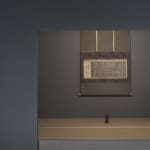Shūhō Myōchō (1282−1337)
Segment of Yifanfeng
Ink on paper, hanging scroll
Mounted together with authentication by Unshu Sotai
With authentication by Tenchu Gisetsu, authentication under the joint signatures of Kosei Sokan, Torin Soyo, and Kakushu Soju
31.2 x 69 cm
129 x 96 cm (overall)
Mounted together with authentication by Unshu Sotai
With authentication by Tenchu Gisetsu, authentication under the joint signatures of Kosei Sokan, Torin Soyo, and Kakushu Soju
31.2 x 69 cm
129 x 96 cm (overall)
Provenance
Collection of Masuda NobuyoExhibitions
Masuda Nobuyo shozohin nyusatsu. Tokyo: Tokyo Art Club, 1924.
When Nampo Jomin was leaving China in 1267 after completing his Zen training, the Chinese monks wrote farewell poems for him. These were collected together under the name Yifanfeng. The original text was lost in a fire, but it was recently announced that the end segment of a copy by Shuho Myocho (a disciple of Nampo Jomin) was now owned by a private collector. This segment previously belonged to Tani Yasutaka, a wealthy merchant from Sakai. At the same time, it was also reported that photographs of two other segments had featured in the Ikeda Seisuke Auction Catalog and the Masuda Nobuyo Auction Catalog, respectively. This is the segment from the latter catalog. It comprises three letters in a scroll box. According to one of these letters, written in 1721 by Tenchu Gisetsu, a priest from the Myoge-in Sub-temple of Tokai-ji Temple, Shuho Myocho’s copy of Yifanfeng was cut into three pieces “at an unknown time,” with one piece in the possession of the Mizuno Izuminokami family and another piece “with authentication by Gyokushu Soban” in Tani Yasutaka’s collection. Tenchu adds that the final piece “fell into my hands, though it was so big I had to cut it in two. I asked Unshu Sotai, abbot of Tokai-ji, to write authentications for both.”
This segment and the one from the Ikeda Seisuke Auction Catalog both feature Unshu’s authentication, so we know they are the two pieces cut in half by Tenchu. The piece from Tani Yasutaka’s collection is now missing Gyokushu Soban’s authentication, but another letter from this segment states that the writer had “recently seen the end segment with Gyokushu’s authentication.”
Shuho Myocho (Zen priest; 1282−1337)
Also known as Daito-kokushi; Kozendaito-kokushi, Koshoshoto-kokushi; Daijiunkyoshin-kokushi.
Harima-born late Kamakura and Nanbokucho-period Rinzai School Zen priest. Founder and the first abbot of Daitoku-ji Temple. His real family name is Ki. Myocho is his Buddhist real name, and Shuho is his pseudonym as a priest. Generally known as “Daito-kokushi,” which comes from “Kozendaito-kokushi” given by the Retired Emperor Hanazono. Entered Shosha-zan Engyo-ji Temple for the learning of Tendai School at the age of eleven. Converted to Zen and followed the teachings of Koho Kennichi of Manju-ji Temple in Kamakura and Nampo Jomin. Founded Daitoku-ji Temple after the death of Nampo and the devotion of the Retired Emperor Hanazono and the Emperor Godaigo.
This segment and the one from the Ikeda Seisuke Auction Catalog both feature Unshu’s authentication, so we know they are the two pieces cut in half by Tenchu. The piece from Tani Yasutaka’s collection is now missing Gyokushu Soban’s authentication, but another letter from this segment states that the writer had “recently seen the end segment with Gyokushu’s authentication.”
Shuho Myocho (Zen priest; 1282−1337)
Also known as Daito-kokushi; Kozendaito-kokushi, Koshoshoto-kokushi; Daijiunkyoshin-kokushi.
Harima-born late Kamakura and Nanbokucho-period Rinzai School Zen priest. Founder and the first abbot of Daitoku-ji Temple. His real family name is Ki. Myocho is his Buddhist real name, and Shuho is his pseudonym as a priest. Generally known as “Daito-kokushi,” which comes from “Kozendaito-kokushi” given by the Retired Emperor Hanazono. Entered Shosha-zan Engyo-ji Temple for the learning of Tendai School at the age of eleven. Converted to Zen and followed the teachings of Koho Kennichi of Manju-ji Temple in Kamakura and Nampo Jomin. Founded Daitoku-ji Temple after the death of Nampo and the devotion of the Retired Emperor Hanazono and the Emperor Godaigo.



